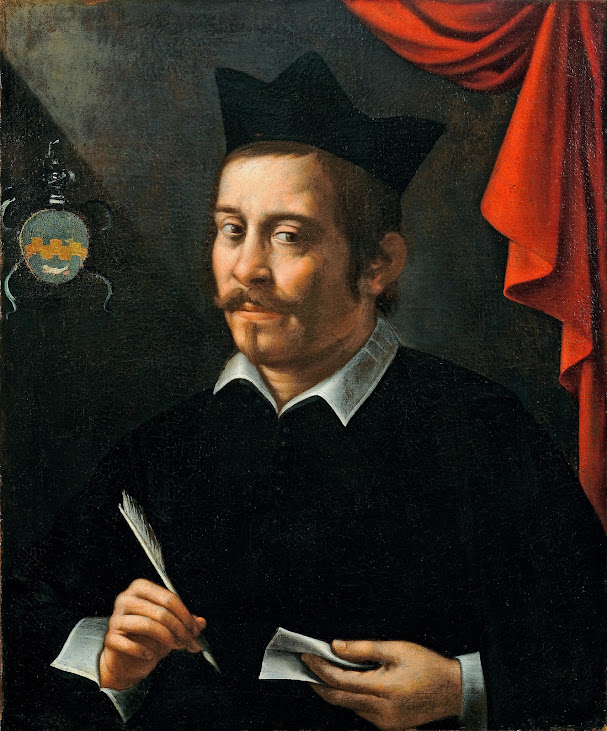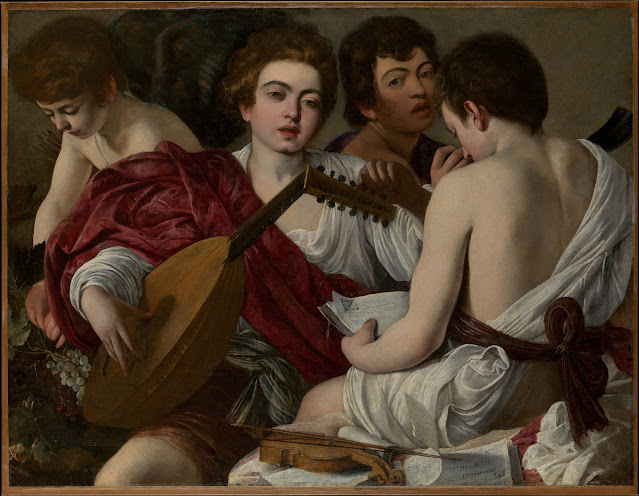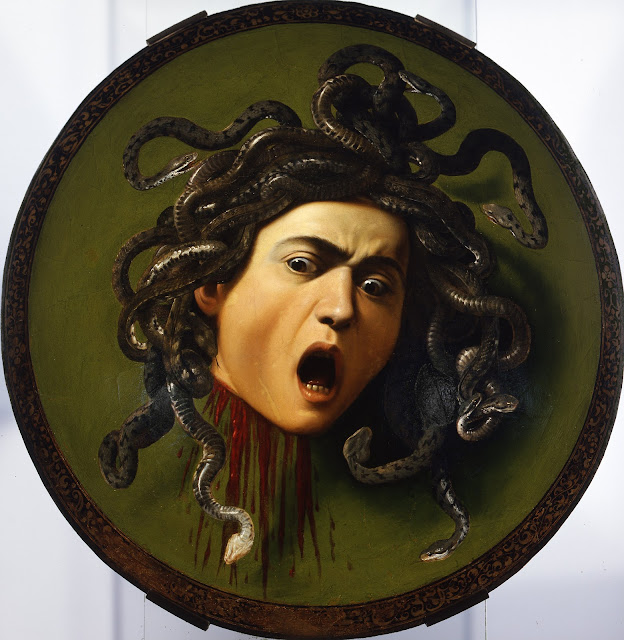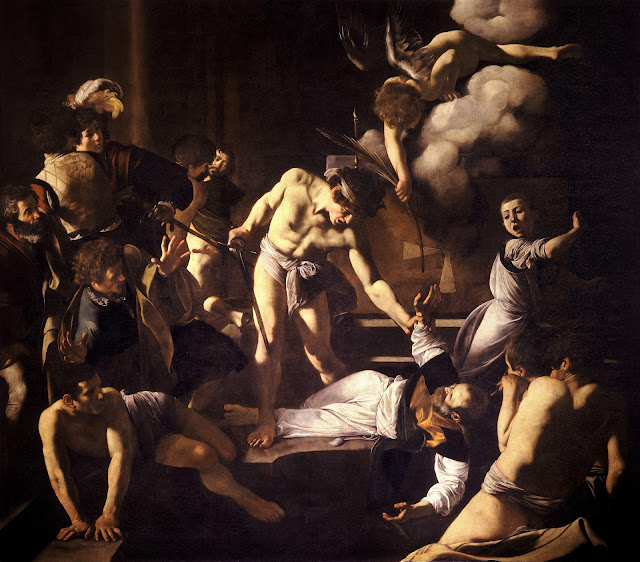 |
| 1593 Self-Portrait as Bacchus oil on canvas 67 x 53 cm Borghese Gallery and Museum, Rome |
Michelangelo Merisi (Michele Angelo Merigi or Amerighi) da Caravaggio, known as simply Caravaggio; 29 September 1571– 18 July 1610), was an Italian painter active in Rome for most of his artistic life. During the final four years of his life he moved between Naples, Malta, and Sicily until his death. His paintings have been characterised by art critics as combining a realistic observation of the human state, both physical and emotional, with a dramatic use of lighting, which had a formative influence on Baroque painting.
Caravaggio employed close physical observation with a dramatic use of chiaroscuro that came to be known as tenebrism. He made the technique a dominant stylistic element, transfixing subjects in bright shafts of light and darkening shadows. Caravaggio vividly expressed crucial moments and scenes, often featuring violent struggles, torture, and death. He worked rapidly, with live models, preferring to forgo drawings and work directly onto the canvas. His inspiring effect on the new Baroque style that emerged from Mannerism was profound. His influence can be seen directly or indirectly in the work of Peter Paul Rubens, Jusepe de Ribera, Giam Lorenzo Bernini, and Rembrandt. Artists heavily under his influence were called the “Caravaggisti” (or "Caravagesques"), as well as tenebrists or tenebrosi (shadowists).
Caravaggio trained as a painter in Milan before moving to Rome when he was in his twenties. He developed a considerable name as an artist, and as a violent, touchy and provocative man. A brawl led to a death sentence for murder and forced him to flee to Naples. There he again established himself as one of the most prominent Italian painters of his generation. He travelled in 1607 to Malta and on to Sicily, and pursued a papal pardon for his sentence. In 1609 he returned to Naples, where he was involved in a violent clash; his face was disfigured and rumours of his death circulated. Questions about his mental state arose from his erratic and bizarre behavior. He died in 1610 under uncertain circumstances while on his way from Naples to Rome. Reports stated that he died of a fever, but suggestions have been made that he was murdered or that he died of lead poisoning.
Caravaggio's innovations inspired Baroque painting, but the latter incorporated the drama of his chiaroscuro without the psychological realism. The style evolved and fashions changed, and Caravaggio fell out of favour. In the 20th century interest in his work revived, and his importance to the development of Western art was reevaluated. The 20th-century art historian André Berne-Joffroy stated: "What begins in the work of Caravaggio is, quite simply, modern painting.”
This is part 1 of a 3-part series on the works of Caravaggio:
 |
| 1592-93 Boy peeling fruit oil on canvas 75.5 x 64.4 cm Longhi Collection, Florence |
This is the earliest known work by Caravaggio, painted soon after his arrival in Rome from his native Milan in mid 1592.
The fruit being peeled by the boy is something of a mystery. Sources indicate it may be a pear, which is probably correct but has been questioned; it may be a nectarine or plum, several of which lie on the table, but these are not usually peeled; some have suggested a bergamot, a pear-shaped citrus fruit grown in Italy, but others object that the bergamot is sour and practically inedible.
Seen as a simple genre painting, it differs from most in that the boy is not 'rusticated,' that is, he is depicted as clean and well-dressed instead of as a 'cute' ragamuffin. An allegoric meaning behind the painting is plausible, given the complex Renaissance symbology of fruit. Caravaggio scholar John T. Spike has recently suggested that the boy demonstrates resistance to temptation by ignoring the sweeter fruits (fruits of sin) in favour of the bergamot, but no specific reading is widely accepted.
There are several fine versions of this composition with claims to be original works by Caravaggio and no reason to suppose that there must be only one such original.
 |
| 1592-95 The Musicians oil on canvas 92.1 x 118.4 cm Metropolitan Museum of Art, New York |
While Cupid confirms Caravaggio’s allegorical frame for representing Music, the artist equally engages with contemporary performance and individualized models, including a self-portrait in the second boy from the right. Caravaggio’s contemporary, Giovanni Baglione, recorded that the artist painted "a concert, with some youths portrayed from nature very well" immediately after joining the household of his first great patron, Cardinal Francesco Maria del Monte. Most likely, this is the same painting and is one of several employing the half-length, earthy yet sensual figures with which Caravaggio made his name upon arriving in Rome.
 |
| 1592-99 Portrait of a Prelate oil on canvas 68 x 53 cm |
 |
| 1593-95 Boy with a basket of fruit oil on canvas 70 x 67 cm Galleria Borghese, Rome |
Boy with a basket of fruit dates to when Caravaggio, who arrived in Rome from Milan, was making his career in the Roman art world. The model was his friend, the Sicilian painter Mario Minniti, at about 16 years old. Primarily, the artwork belonged to Giuseppe Cesari, the Cavaliere d’Arpino, seized by Cardinal Scipione Borghese in 1607. Many historians refer to other works of the same period featuring Minniti as a model, such as The Fortune Teller and the Cardsharps from 1594. In addition, the Cardsharps brought Caravaggio to the attention of his first significant patron, Cardinal Francesco Maria del Monte.
 |
| 1594-95 Patient Mary Magdalene oil on canvas 106 x 97 cm Doria Pamphilj Gallery, Rome |
 |
| 1594-95 Patient Mary Magdalene oil on canvas 106 x 97 cm Doria Pamphilj Gallery, Rome |
Caravaggio's Penitent Mary Magdalene (also known as Repentant Magdalene) is a powerful statement – but what, precisely, that statement is, is unknown. Some critics felt that Caravaggio was making a statement about the treatment of prostitutes in his own time, using the Bible's best known fallen woman to raise awareness of the violence that these women faced. Magdalene, they say, is depicted slumped and defeated, her hands and face swollen, the violence implicit in the strand of broken pearls on the floor beside her.
Regardless of Caravaggio's intentions, his contemporaries were horrified by his depiction of Mary Magdalene as a modern (for their day) woman. She is attired in clothing that could have been seen on women in the streets and houses of Caravaggio's home town, and this clear linking of the Bible's alleged prostitute with modern women sat uncomfortably with many religious authorities. But this disapproval was not universal – many clerics praised the painting, embracing the realism of the portrait and the clear lines of remorse and regret to be seen in the position of the woman's body.
 |
| c1594-95 The Fortune Teller oil on canvas 115 x 150 cm Musei Capitolini Pinocateca, Rome |
 |
| 1594-96 Boy bitten by a Lizard oil on canvas 66 x 49.5 cm The National Gallery, London |
An effeminate youth recoils in pain as he is bitten by a lizard, which clings tenaciously to his finger. In the foreground is a magnificent still life of fruit, with a rose and sprig of jasmine in a glass vase. Look closely and you can see the reflection of a room in the curved surface of the vase. The painting may have an allegorical meaning, and possibly refers to the pain that can derive from love.
It is very unusual for a late sixteenth-century painting to show such a moment of action, but Caravaggio rejected artistic convention and painted directly onto the canvas from live models. This gave his works an immediacy and intensity that made them instantly popular. Numerous early seventeenth-century copies and derivations of this painting exist, including a high-quality replica in the Fondazione Longhi, Florence, considered by many to be by Caravaggio himself.
 |
| 1594-96 The Rest on the Flight into Egypt oil on canvas 130 x 160 cm Galleria Doria Pamphilj, Rome |
The scene is based not on any incident in the Bible itself, but on a body of tales or legends that had grown up in the early Middle Ages around the Bible story of the Holy Family fleeing into Egypt for refuge on being warned that Herod the Great was seeking to kill the Christ Child. According to the legend, Joseph and Mary paused on the flight in a grove of trees; the Holy Child ordered the trees to bend down so that Joseph could take fruit from them, and then ordered a spring of water to gush forth from the roots so that his parents could quench their thirst. This basic story acquired many extra details during the centuries. Caravaggio shows Mary asleep with the infant Jesus, while Joseph holds a manuscript for an angel who is playing a hymn to Mary on the viol.
 |
| 1595 The Musicians oil on canvas 92.1 x 118.4 cm Metropolitan Museum of Art, New York |
 |
| 1595-96 The Lute-Player oil on canvas 94 x 119 cm The State Hermitage Museum, St. Petersburg, Russia |
Caravaggio painted The Lute Player in his early period, before his religious subjects. After moving to Rome from Milan, Caravaggio found work painting still lifes, figures playing games, and other images of musicians. In Rome, he started relationships with important and influential people that were instrumental in his progression as an artist. The Cardinal Francesco Maria Del Monte was an important diplomatic person in seventeenth century Italy and a well-known patron of the arts. Many of Caravaggio’s commissions, including The Lute Player, were from Del Monte for his personal collection. There are three versions of Caravaggio’s Lute Player, but all have very similar compositions. They all have a boy in the center holding a stringed instrument – the lute. The figure is the same in the paintings: an adolescent boy with dark hair, light skin, and delicate features. He is shown in the middle of playing a song with his hands plucking the strings and his mouth slightly open, singing a song about love.
 |
| 1595-97 The Adolescent Bacchus oil on canvas 95 x 85 cm Uffizi Gallery, Florence |
The painting is listed in the 17-18th century inventories of the Villa di Artiminio from 1609; such an early date supports the hypothesis that it was given, along with the Medusa, by cardinal Francesco Maria del Monte to the Grand Duke Ferdinando I. It was found in the Uffizi storage facilities in 1916. It shows youthful Bacchus reclining in classical fashion with grapes and vine leaves in his hair, fingering the drawstring of his loosely draped robe. On a stone table in front of him is a bowl of fruit and a large carafe of red wine. He holds out a shallow goblet of the same wine, inviting the viewer to join him.
.jpg) |
| c1595 The Cardsharps oil on canvas 94 x 131 cm Kimbell Art Museum, Fort Worth, Texas |
The Cardsharps came to the attention of the influential Cardinal Francesco Maria del Monte, who not only purchased it but also offered the artist quarters in his palace. Caravaggio was thus introduced to the elite stratum of Roman ecclesiastical society, which soon gave him his first significant opportunity to work on a large scale and for a public forum.
In The Cardsharps, the players are engaged in a game of primero, a forerunner of poker. Engrossed in his cards at left is the dupe, unaware that the older cardsharp signals his accomplice with a raised, gloved hand (the fingertips exposed, better to feel marked cards). At right, the young cheat looks expectantly toward the boy and reaches behind his back to pull a hidden card from his breeches. Caravaggio has treated this subject not as a caricature of vice but in a novelistic way, in which the interaction of gesture and glance evokes the drama of deception and lost innocence in the most human of terms. It spawned countless paintings on related themes by artists throughout Europe—not the least of which was Georges de La Tour’s Cheat with the Ace of Clubs in the Kimbell.
The Cardsharps was stamped on the back with the seal of Cardinal del Monte and inventoried among his possessions after his death in 1627. Its location had been unknown for some ninety years when it was rediscovered in 1987 in a European private collection.
 |
| c1595 The Fortune Teller oil on canvas 93 x 131 cm Louvre, Paris |
With The Fortune Teller, Caravaggio introduced a new subject into Italian art. Unlike most Italian paintings of the Renaissance and Baroque periods, The Fortune Teller does not take its theme from the Bible or Greco-Roman mythology, but instead is a genre picture, or a scene of daily life. Genre paintings were extremely popular in Northern Europe, abounding in Dutch art. Northern paintings and prints were becoming quite popular at the end of the sixteenth century especially in northern Italy and Caravaggio most likely became familiar with them during his years as an artist's apprentice in the Lombardy region.
Caravaggio depicts a wealthy, foppish young man having his palm read by a seemingly innocent gypsy girl (identifiable by her unique attire). Naively trusting and apparently easily distracted by the fairer sex, the boy flirtatiously gazes into the gypsy girl's eyes while she (according to contemporary sources) slightly slips the ring off his finger. Just like Northern genre paintings, the painting is imbued with a subtle moral lesson.
 |
| 1596 Medusa, called Medusa Murtola oil on canvas mounted on panel 48-49 cm diameter Private Collection |
 |
| 1597 Medusa oil on canvas mounted on wood panel 60 x 55 cm Uffizi Gallery, Florence |
Two versions of Medusa were created by – one in 1596 and the other in 1597 – depicting the exact moment she was executed by Perseus. He plays with the concept by replacing Medusa's face with his own, as an indication of his immunity to her dreadful gaze. Due to its bizarre and intricate design, the painting is said to complement Caravaggio's unique fascination with violence and realism. It was commissioned by Italian diplomat Francesco Maria de Monte as a means of giving it to the Grand Duke of Tuscany, and is now located in the Uffizi Museum in Florence without signature.
.jpg) |
| 1597-1600 Jupiter, Neptune and Pluto fresco 180 x 300 cm Casino Boncompagni Ludovisi, Rome |
Villa Aurora was put up for auction in Rome at $546 million however failed to sell even with a $360 million one-of-a-kind 16th century mural. Known by its official name of Casino di Villa Boncompagni Ludovisi, the Italian abode was owned by the late Prince Nicolo Boncompagni Ludovisi and is now being sold by the Italian government due to inheritance issues between his children and his wife Princess Rita Boncompagni Ludovisi.
However, what makes this house worth an exuberant amount isn’t the house itself but what’s inside. This is the only ceiling mural undertaken by Caravaggio.
The mural depicts the Roman gods of Jupiter, Neptune and Pluto with animals that include an eagle and mythical creatures like the Hippocampi and three-headed dog Cerberus. Cardinal Francesco Maria Del Monte commissioned Caravaggio to paint the Mural in 1597 with the piece now over 400 years old, it’s estimated to be worth $360 million.
.jpg) |
| 1598 Maffeo Barberini oil on canvas 124 x 90 cm Private Collection |
Maffeo Barberini, 30 years old and from the eminent Florentine Barberini family, was a rapidly rising Church prelate, a friend of Caravaggio's patron Cardinal Francesco Maria Del Monte, and himself a poet and patron of the arts. Barberini's support would continue into later years – in 1603 he commissioned a Sacrifice of Isaac from Caravaggio. In 1623 he became Pope as Urban VIII.
 |
| 1598-99 Judith beheading Holofernes oil on canvas 145 x 195 cm Galleria Nazionale d'Arte Antica, Rome |
 |
| 1598-1610 Judith beheading Holofernes oil on canvas 144 x 173.5 cm Private Collection |
 |
| c1598 Martha and Mary Magdalene oil and tempera on canvas 100 x 134.5 cm Detroit Institute of Arts, MI |
Caravaggio introduced dramatic effects of light and shadow in his paintings and often used ordinary-looking people to illustrate religious stories. Artists from Italy, as well as from other European countries, adopted his style.
In the sixteenth century a new emphasis was placed on Mary Magdalen's role as a converted sinner. Caravaggio depicts Mary's sister Martha, dressed modestly, reproaching her sister for her wayward conduct and enumerating on her fingers the miracles of Christ. This exact moment of the conversion was obviously a tremendous challenge for the painter because the change is spiritual rather than physical. Caravaggio's solution was to manipulate the light that illuminates the Magdalen, giving her an unearthly glow. The mirror, a traditional Image of vanity, now reflects the light of divine revelation.
 |
| c1598 Saint Catherine of Alexandria oil on canvas 173 x 133 cm Museo Nacional Thyssen-Bornemisza, Madrid |
The painting was part of the collection of Cardinal Francesco Del Monte, where it was cataloged in 1627. The saint, together with Mary Magdelene, were among the Cardinal's favorites. According to Alessandro Zuccari, it was painted on the suggestion of the Cardinal when Caravaggio was living with him in the Palazzo Madama.
As the model for the saint, Caravaggio controversially chose Fillide Melandroni, a well known Roman prostitute he had fallen in love with and who caused him many problems. Fillide would again model for him in “Martha and Mary Magdalene,” “Judith Beheading Holorfeness,” and in a single portrait burned in Berlin during World War II.
Saint Catherine of Alexandria was a popular figure in Catholic iconography. Her qualities are supposed to be those of beauty, fearlessness, virginity, and intelligence.She was of noble origins, and dedicated herself as a Christian after having a vision. At the age of 18 she confronted the Roman Emperor Maximus, debated his pagan philosophers, and succeeded in converting many of them to Christianity. Imprisoned by the emperor, she converted his empress and the leader of his armies. Maximus executed her converts (including the empress) and ordered that Catherine herself be put to death on a spiked wheel. The wheel reportedly shattered the moment Catherine touched it. Maximus then had her beheaded.
 |
| 1599-1600 The Calling of Saint Matthew oil on canvas 340 x 322 cm Contarelli Chapel, Church of San Luigi dei Francesi, Rome |
The painting depicts the moment at which Jesus Christ inspires Matthew to follow him. Over a decade before, Cardinal Matteo Contarelli had left in his will funds and specific instructions for the decoration of a chapel based on themes related to his namesake, Saint Matthew. The dome of the chapel was decorated with frescoes by the late Mannerist artist Giuseppe Cesari, Caravaggio's former employer and one of the most popular painters in Rome at the time. But as Cesari became busy with royal and papal patronage, Cardinal Francesco Del Monte, Caravaggio's patron and also the prefect of the Fabbrica of St Peter's (the Vatican office for Church property), intervened to obtain for Caravaggio his first major church commission and his first painting with more than a handful of figures.
 |
| 1599-1600 The Martyrdom of Saint Matthew oil on canvas 323 x 343 cm San Luigi dei Francesi, Rome |
The painting shows the martyrdom of Saint Matthew the Evangelist, author of the Gospel of Matthew. According to tradition, the saint was killed on the orders of the king of Ethiopia while celebrating Mass at the altar. The king lusted after his own niece, and had been rebuked by Matthew, for the girl was a nun, and therefore the bride of Christ. Cardinal Contarelli, who had died several decades earlier, had laid down very explicitly what was to be shown: the saint being murdered by a soldier sent by the wicked king, some suitable architecture, and crowds of onlookers showing appropriate emotion.
The commission (which, strictly speaking, was from his patron, Cardinal Francesco Maria Del Monte, rather than from the church itself), caused Caravaggio considerable difficulty, as he had never painted so large a canvas, nor one with so many figures. X-rays reveal two separate attempts at the composition before the one we see today, with a general movement towards simplification through reduction in the number of figures, and reduction – ultimately elimination – of the architectural element. The figure in the background, about left-centre and behind the assassin, is a self-portrait by Caravaggio.
 |
| c1599-1600 Narcissus oil on canvas 110 x 92 cm Galleria Nazionale d'Arte Antica, Rome |
This is one of only two known Caravaggios on a theme from Classical mythology, although this is due more to the accidents of survival than the artist's oeuvre. Narcissus, according to the poet Ovid in his “Metamorphoses,” is a handsome youth who falls in love with his own reflection. Unable to tear himself away, he dies of his passion, and even as he crosses the Styx continues to gaze at his reflection.
Caravaggio painted an adolescent page wearing an elegant brocade doublet, leaning with both hands over the water, as he gazes at this own distorted reflection. The painting conveys an air of brooding melancholy: the figure of Narcissus is locked in a circle with his reflection, surrounded by darkness, so that the only reality is inside this self-regarding loop. The 16th century literary critic Tommaso Stigliani explained the contemporary thinking that the myth of Narcissus "clearly demonstrates the unhappy end of those who love their things too much."
 |
| c1599 Basket of Fruit oil on canvas 31 x 47cm Pinacoteca Ambrosiana, Milan |
Much has been made of the worm-eaten, insect-predated, and generally less than perfect condition of the fruit. In line with the culture of the age, the general theme appears to revolve about the fading beauty, and the natural decaying of all things. Scholars also describe the basket of fruit as a metaphor of the Church.
In 1607 it was part of Cardinal Federico Borromeo’s collection, a provenance which raises the plausibility of a conscious reference to the Book of Amos. Borromeo, who was archbishop of Milan, was in Rome approximately 1597-1602 and a house guest of Del Monte in 1599. He had a special interest in the Northern European painters such as Paul Bril and Jan Brueghel the Elder, who were also in Rome at the time, (indeed, he took Breughel into his own household), and in the way they did landscapes and flowers in paintings as subjects in their own right, something not known at the time in Italian art.
 |
| 1600 David and Goliath oil on canvas 110.4 x 91.3 cm Museo del Prado, Madrid |
David and Goliath was painted while the artist was a member of the household of Cardinal Francesco Maria Del Monte, It shows the Biblical David as a young boy (in accordance with the Bible story) fastening the head of the champion of the Philistines, the giant Goliath, by the hair. The light catches on David's leg, arm and flank, on the massive shoulders from which Goliath's head has been severed, and on the head itself, but everything else is dark. Even David's face is almost invisible in the shadows. A wound on Goliath's forehead shows where he has been felled by the stone from David's sling.
No comments:
Post a Comment
Note: only a member of this blog may post a comment.